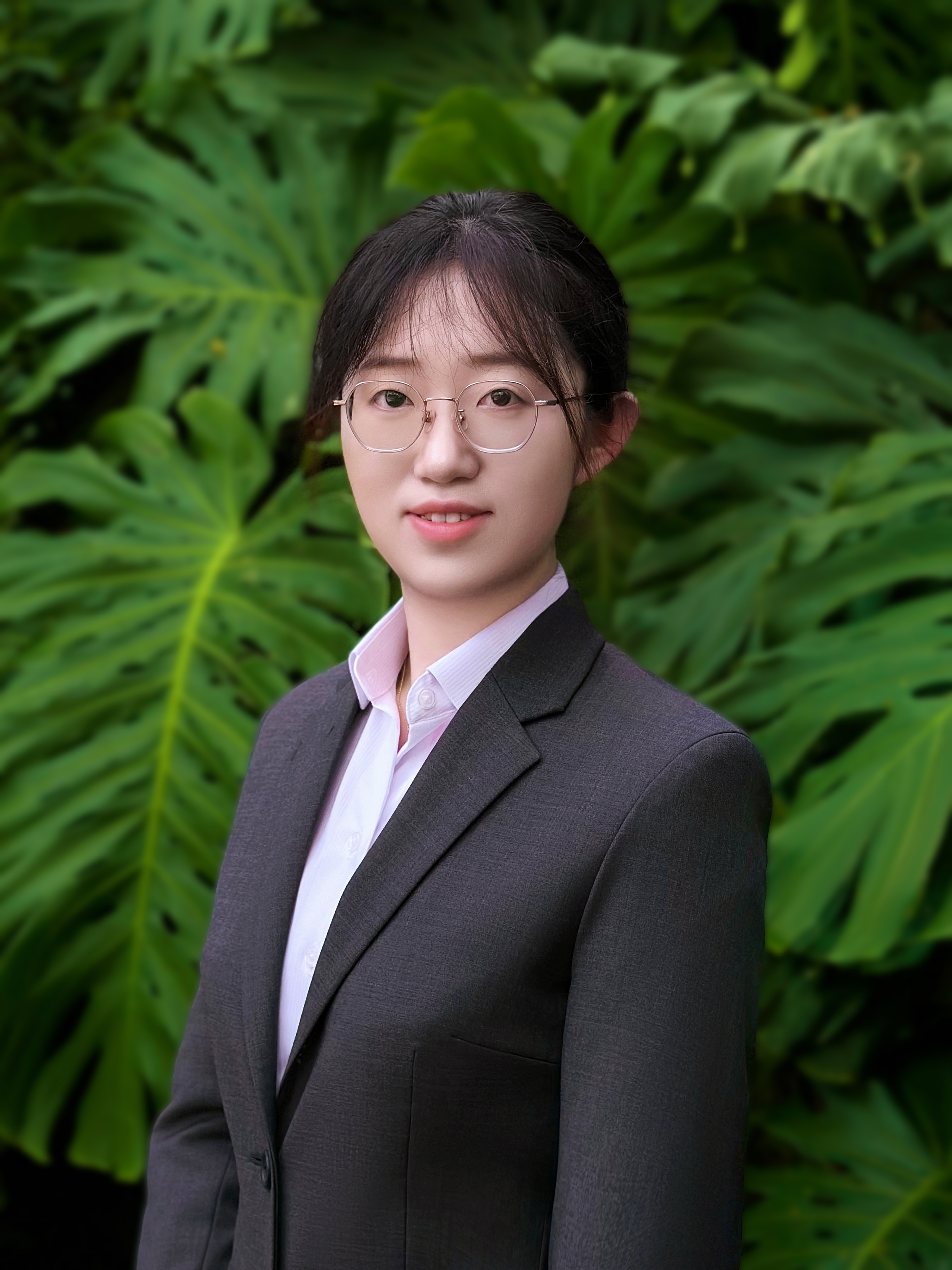ZHU XIAOFAN
Ph.D Candidate in Economics
I am a job market candidate and I will be available for interviews.
REFERENCES
Professor Fali Huang
Email: flhuang@smu.edu.sg
Tel: +65 68280859
Professor Sunha Myong
Email: sunhamyong@smu.edu.sg
Tel: +65 68281914
WORKING PAPERS
“Educational Decisions in the Shadow of Cronyism: An Empirical Study of College Graduates in
China”, with Chen Xiang (Job Market Paper)
This study investigates how inefficient political institutions, marked by rampant corruption and cronyism,
shape students’ educational choices based on their family’s political connections. We exploit the onset of
China’s anti-corruption campaign and compare the educational choices of college students with at least
one cadre parent versus those without, from more corrupt regions versus less corrupt regions, before and
after the campaign. We find that after the campaign, college students with at least a cadre parent from
regions previously characterised by higher corruption levels are more likely to pursue further education
after graduation. The effects are more pronounced for male students, for students with liberal art track
majors, for students with lower academic performance during college, and for students with cadre parents
with higher positional ranks. Moreover, we examine the underlying mechanisms and find evidence of a
more equitable post-campaign employment environment, where connected students need stronger
educational qualifications and more human capital stock to remain competitive against their unconnected
counterparts.
“How On-campus Residence Influences Academic Success and Non-academic Outcomes", with
Sujata Visaria, Xuanyi Jin, and Chen Xiang.
This study examines the impact of on-campus residence halls on academic and labor market outcomes, as well as subjective wellbeing among students at a first-tier university in Hong Kong. Leveraging administrative data and a random allocation system, we find that students residing in halls exhibit lower yearly Grade Point Averages, receive fewer job offers upon graduation, and report higher satisfaction with their hall experience. Across the complete sample of students analyzed, male students are particularly influenced by hall residency. We further study the underlying mechanisms and identify that underutilization of school learning facilities and fewer full-time internships of hall residents may contribute to the observed academic and labor market performance differences. Our research contributes to understanding the role of college amenities in human capital accumulation and sheds light on genderspecific effects of on-campus residence.
“Religiosity and Family Firms: Evidence from China”
WANG YUTAO
Ph.D Candidate in Economics
I am a job market candidate and I will be available for interviews.
REFERENCES
Professor Christine Ho
Email: christineho@smu.edu.sg
Tel: +65 68085173
Professor Tomoki Fujii
Email: tfujii@smu.edu.sg
Tel: +65 68280279
WORKING PAPERS
“Social Institutions and Low Birth Rates”, with Christine Ho (Job Market Paper)
We document three cross-sectional stylized facts on labor supply and family formation. First, female labor force participation (LFP) and fertility rates are much lower in Eastern societies compared to Western economies. Second, labor hours and the gender-pay gap are much higher in the East than in the West. Third, parents spend very high amounts of time and money per child in Eastern societies. To account for these features, we develop and estimate a rich heterogeneous-agent model with endogenous marriage, fertility, labor supply, and time and money investment in children. Estimates using data from South Korea and the United States highlight the importance of gender norms and long work hours practices in driving down female LFP while child quality mores drive down fertility in South Korea. Our results suggest that a multi-pronged policy approach or reductions in the gender-pay gap may help boost both female LFP and fertility in East Asia.
RESEARCH PAPERS
“Family Size and Child Migration: Do Daughters Face Greater Trade-Offs than Sons?”, with Christine Ho and Sharon Xuejing Zuo
We show that, conditional on family size, rural boys and girls are equally likely to migrate with parents in China. Nevertheless, daughters’ migration may still be compromised because they tend to have more siblings in societies with strong son preference, and larger families are more likely to leave all children behind. We find that a one unit increase in sibship size decreases the probability that a daughter migrates by 12.5 percentage points—with stronger effects when migration restrictions are more stringent—but has negligible effects on sons. The results suggest that gender-neutral migration constraints may generate gendered family size trade-offs.

WANG KEXIN
Ph.D Candidate in Economics
I am a job market candidate and I will be available for interviews.
REFERENCES
Professor Jiangtao Li
Email: tli@smu.edu.sg
Tel: +65 68261351
Professor Wei He
Email: hewei@cuhk.edu.hk
Tel: (852) 3943-8196
Professor Jingyi Xue
Email: jyxue@smu.edu.sg
Tel: +65 68085466
Professor Tilman Börgers
Email: tborgers@umich.edu
Tel: +-1-734-764 8022
WORKING PAPERS
"Robust Contracting under Distributional Uncertainty", with Jiangtao Li (Job Market Paper)
We study the design of contracts when the principal has limited statistical information about the output distributions induced by the agent’s actions. In the baseline model, we consider a principal who only knows the mean of the output distribution for each action. The mean restrictions allow for large set of profiles of output distributions, including some extreme output distributions that can be used to establish the robust optimality of monotone affine contracts. Motivated by this, we study the set of distributions that can be used to establish the robust optimality of the monotone affine contracts. This facilitates the understanding for the use of monotone affine contracts in settings with more restrictions on the output distributions. Our main result shows that the optimality of monotone affine contracts persists even if the principal has access to other information about the output distributions, such as the information that the output distribution induced by each action has full support.
RESEARCH PAPERS
"A Robust Optimization Approach to Mechanism Design", with Jiangtao Li
We study the design of mechanisms when the mechanism designer faces local uncertainty about agents’ beliefs. Specifically, we consider a designer who does not know the exact beliefs of the agents but is confident that her estimate is within ε of the beliefs held by the agents (where ε reflects the degree of local uncertainty). Adopting the robust optimization approach, we design mechanisms that incentivize agents to truthfully report their payoff-relevant information regardless of their actual beliefs. For any fixed ε, we identify necessary and sufficient conditions under which requiring this sense of robustness is without loss of revenue for the designer. By analyzing the limiting case in which ε approaches 0, we provide two rationales for the widely studied Bayesian mechanism design framework.
“Interim Regret Minimization”, with Wei He, Jiangtao Li
We consider a robust version of monopoly pricing when the seller only knows the bound on valuations and the mean of the distribution of the buyer’s value. The seller seeks to minimize interim regret, the forgone expected revenue due to not knowing the distribution of the buyer’s value. The optimal pricing policy randomizes over a range of prices; the support of the pricing policy is bounded away from zero.
“Undominated Mechanisms”, with Tilman Börgers, Jiangtao Li
We study the design of mechanisms when the designer faces multiple plausible scenarios and is uncertain about the true scenario. A mechanism is dominated by another if the latter performs at least as well in all plausible scenarios and strictly better in at least one. A mechanism is undominated if no other feasible mechanism dominates it. We show how analyzing undominated mechanisms could be useful and illustrate the tractability of characterizing such mechanisms. This approach provides an alternative criterion for mechanism design under uncertainty, complementing existing methods.
“Optimal Multiperiod Allocation with Costly Verification”
We study the optimal design of mechanisms in which the principal is to allocation goods to an agent over two periods. In each period, the principal can verify the agent’s private information at a cost, but monetary transfers are not allowed. In particular, we consider that the agent’s private value for a good is either high or low in each period. And the values are independent and identically distributed over two periods. In our main results, we first show that it is always suboptimal to check the agent’s information for sure in the first period when he reports the high value. This contrasts with the optimality for the static allocation problem that has been studied in Ben-Porath, Dekel, and Lipman (2014), in which verifying the high value with probability one maximizes the principal’s expected payoff when certain conditions are satisfied. Second, we explicitly solve out the optimal mechanisms, which strongly depend on the choice of model parameters, including the valuations, the verification cost as well as the value distributions. We also discuss the optimal mechanisms when the agent’s values exhibit two extreme correlation structures, which are maximal positive correlation or maximal negative correlation.

SONG YUNLONG
Ph.D Candidate in Economics
I am a job market candidate and I will be available for interviews.
REFERENCES
Professor Lin Ma
Email: linma@smu.edu.sg
Tel: +65 68280876
Professor Yuan Mei
Email: yuanmei@smu.edu.sg
Tel: +65 68085212
Professor Jing Li
Email: lijing@smu.edu.sg
Tel: +65 68085454
Professor Yang Tang
Email: tangyang@ntu.edu.sg
Tel: +65 6790 6115
WORKING PAPERS
"Physical and Human Capital Accumulation in a Spatial Economy", with Lin Ma and Yang Tang (Job Market Paper)
We study how production factor accumulations in space respond to economic shocks and how those responses modify the aggregate and distributional impacts of shocks. To examine their responses and implications, we develop a dynamic spatial model that incorporates capital accumulation and skill acquisition. Focusing on China’s trade liberalization and infrastructure expansion in the early 2000s, we show that allowing for capital accumulation amplifies welfare gains and intensifies inequality across skill types, while skill acquisition attenuates impacts on skill premiums by balancing skill supply in response to shocks. Our findings also highlight the critical role of capital-skill interactions in shaping aggregate and spatial impacts, suggesting that both capital and skill adjustments are essential to understanding the full impacts of economic shocks on welfare and inequality.
RESEARCH PAPERS
"The Spatial General Equilibrium Impacts of Inward FDI", with Lin Ma
We study the spatial general equilibrium impacts of inward FDI using a dynamic spatial model with capital being allowed to move across borders. Focusing on China, we explicitly estimate FDI barriers at prefectural level, FDI elasticity, and FDI knowledge spillover elasticity. Using IV constructed from China’s early 2000s FDI policy liberalization, we find a positive knowledge spillover of inward FDI. In quantitative analysis, we show that inward FDI has a substantial positive impact on welfare in China due to FDI knowledge spillover, with coastal cities gaining more. We also explore the role of local FDI barriers in explaining regional inequality in China: eliminating the barriers reduces China’s regional inequality but also decreases its total income.

REN YUEXUAN
Ph.D Candidate in Economics
I am a job market candidate and I will be available for interviews.
REFERENCES
Professor Jia LI
Email: jiali@smu.edu.sg
Tel: +65 68280707
Professor Yichong Zhang
Email: yczhang@smu.edu.sg
Tel: +65 68280881
Professor Peter C.B. Phillips
Email: peterphillips@smu.edu.sg
Tel: +65 68280865
Professor Jun Yu
Email: junyu@um.edu.mo
Tel: +853 8822-4716
WORKING PAPERS
"Conformal Prediction for High-Frequency Event Studies" (Job Market Paper)
We propose using a conformal predictive analysis for high-frequency event studies. Unlike existing literature, we recast the inference problem of cumulative abnormal return (CAR) as a counterfactual prediction problem for cumulative return. The general continuous-time model for spot regression can be approximated by a linear regression model with independent and stable-distributed random variables under the fixed-k asymptotic setting, thereby establishing the asymptotic validity of the conformal prediction interval. Extending the theory to incorporate a counterfactual model with many control units, the proposed prediction interval remains valid when using the synthetic control estimator. An intraday event study of AMD’s conference session illustrates the empirical application.
RESEARCH PAPERS
"Robust Inference for Spot Regressions", with Tim Bollerslev, Jia Li and Ulrich Müller.
“A Robust test of Tracking Performance for Leveraged ETFs”, with Tim Bollerslev, Jia Li and Ulrich Müller
PUBLICATION
"Optimal Inference for Spot Regressions.", with Tim Bollerslev, Jia Li, and Yuexuan Ren, American Economic Review, 114 (3): 678-708, 2024

CONTACT INFORMATION
Ph.D Candidate in Economics
I am a job market candidate and I will be available for interviews.
REFERENCES
Professor CHANG Pao Li
Email: plchang@smu.edu.sg
Tel: +65 68280830
Professor MEI Yuan
Email: yuanmei@smu.edu.sg
Tel: +65 68085212
Professor MA Lin
Email: linma@smu.edu.sg
Tel: +65 68280876
WORKING PAPERS
"Using Satellite-observed Geospatial Inundation Data to Identify the Impacts of Flood on Firm-level Performances: The Case of China during 2000--2009", With Pao-Li Chang (Job Market Paper)
Among the first in the literature, this paper combines high-resolution satellite-observed inundation maps with geocoded firm-level data to identify the flood exposure at the firm level. We apply the methodology to study the impact of floods on micro-level firm performances in China for the period 2000-2009. Being hit by a flood is associated with an annual loss of output and productivity of around 6% and 5%, respectively, which persists in the long run. The effects are heterogeneous across types of firms and locations of the floods. Firms that are tangible-asset intensive are more negatively affected by the flood events. Meanwhile, the effects on firms located in flood-prone counties are less severe and shorter-lived, suggesting better adaptation of firms experienced with floods. The impacts of floods extend to non-inundated firms in surrounding areas (of 4 kilometres in radius), but the negative effects are much smaller (2% on average) and diminish after three years. Firms beyond the immediate neighborhood expand their output from the second year onward, in contrast with the permanent shrinkage of the inundated firms. By aggregating the firm-level data to the county level, we further identify negative effects of floods at the extensive margin: the firm exit (entry) rate is higher (lower) in counties that are hit by floods, and the effects are stronger in counties subject to more severe floods.
"The Response of the Chinese Economy to the U.S.-China Trade War: 2018-2019", With Pao-Li Chang and Kefang Yao
In this paper, we follow the micro-to-macro approach of Fajgelbaum et al. (2020) and analyze the impacts of the 2018-2019 U.S.-China trade war on the Chinese economy. We use highly disaggregated trade and tariff data with monthly frequency to identify the demand/supply elasticities of Chinese imports/exports, combined with a general equilibrium model for the Chinese economy (that takes into account input-output linkages, and regional heterogeneity in employment and sector specialization) to quantify the partial and general equilibrium effects of the tariff war. This complements the studies focused on the ex post response of the U.S. economy by Amiti et al. (2019), Flaaen et al. (2020), Fajgelbaum et al. (2020), and Cavallo et al. (2021).

XIA YING
Ph.D Candidate in Economics
I am a job market candidate and I will be available for interviews.
REFERENCES
Professor SU Liangjun
Email: sulj@sem.tsinghua.edu.cn
Tel: +86 10 62789506
Professor Yichong ZHANG
Email: yczhang@smu.edu.sg
Tel: +65 68280881
Professor Peter C. B. PHILLIPS
Email: peter.phillips@yale.edu
Tel: (203) 432-3695
WORKING PAPERS
"Efficient Nonparametric Estimation of the Generalized Panel Data Transformation Models with Fixed Effects", (Job Market Paper)
In this article, we consider a generalized panel data transformation model with fixed effects where the structural functions are assumed to be additive. Our model does not impose parametric assumptions on the transformation function, the structural function, or the distribution of the idiosyncratic error term. We propose a multiple-stage Local Maximum Likelihood Estimator (LMLE) for the structural functions. In the first stage, we apply the regularized logistic sieve method to estimate the sieve coefficients associated with the approximation of a composite function and then apply a matching method to obtain initial consistent estimators of the additive structural functions. In the second stage, we apply the local polynomial method to estimate certain composite function and its derivatives to be used later on. In the third stage we apply the local linear method to obtain the refined estimator of the additive structural functions based on the estimators obtained in Steps 1 and 2. The greatest advantage is that all minimization problems are convex and thus overcome the computational hurdle for existing approaches to the generalized panel data transformation model. The final estimates of the additive terms achieve the optimal one-dimensional convergence rate, asymptotic normality and oracle efficiency. The Monte Carlo simulations demonstrate that our new estimator performs well in finite samples.
"Efficient Nonparametric Estimation of the Generalized Additive Model with an Unknown Link Function"
In this article, we consider a generalized additive model with an unknown link function (GAMULF). Our model does not impose parametric assumptions on the link function or the distribution of the idiosyncratic error term. We propose a three-stage nonparametric least squares (NPLS) estimation procedure for the additive functions. In the first stage, we estimate conditional expectation by the local-linear kernel regression and then apply matching method to the splines series to obtain initial estimators. In the second stage, we use the local-polynomial kernel regression to estimate the link function. In the third stage, given the estimators in Stages 1 and 2, we apply the local linear kernel regression to refine the initial estimator. The great advantage of such a procedure is that the estimators obtained at all stages have closed-form expressions, which overcomes the computational hurdle for existing estimators of the GAMULF model. The final estimators of the additive terms achieve the optimal one-dimensional convergence rate, asymptotic normality and oracle efficiency. Monte Carlo simulations demonstrate that our new estimator performs well in finite samples.

WANG YIREN
Ph.D Candidate in Economics
I am a job market candidate and I will be available for interviews.
REFERENCES
Professor Yichong ZHANG
Email: yczhang@smu.edu.sg
Tel: +65 68280881
Professor SU Liangjun
Email: sulj@sem.tsinghua.edu.cn
Tel: +86 10 62789506
Email: peter.phillips@yale.edu
Tel: (203) 432-3695
Professor Jia LI
Email: jiali@smu.edu.sg
Tel: +65 68280890
WORKING PAPERS
"Panel Data Models with Time-Varying Latent Group Structures", with Peter C.B. Phillips and Liangjun Su (Job Market Paper)
This paper considers a linear panel model with interactive fixed effects such that individual heterogeneity is captured by latent group structure and time heterogeneity is captured by an unknown structural break. We allow the model to have different numbers of groups and/or different group memberships before and after the break. With the preliminary estimates by nuclear norm regularization followed by row- and column-wise linear regressions, we estimate the break point based on the idea of binary segmentation and the latent group structures together with the number of groups before and after the break by sequential testing K-means algorithm simultaneously. We show that the break point, the number of groups and the group membership can be estimated correctly with probability approaching one. Finite sample performance of the methodology is illustrated via Monte Carlo simulations and a real dataset application.
"Low-rank Panel Quantile Regression: Estimation and Inference", with Liangjun Su and Yichong Zhang (Submitted to Annals of Statistics)
In this paper, we propose a class of low-rank panel quantile regression models which allow for unobserved slope heterogeneity over both individuals and time. We estimate the heterogeneous intercept and slope matrices via nuclear norm regularization followed by sample splitting, row- and column-wise quantile regressions and debiasing. We show that the estimators of the factors and factor loadings associated with the intercept and slope matrices are asymptotically normally distributed. In addition, we develop two specification tests: one for the null hypothesis that the slope coefficient is a constant over time and/or individuals under the case that the true rank of slope matrix equals one, and the other for the null hypothesis that the slope coefficient exhibits an additive structure under the case that the true rank of slope matrix equals two. We also illustrate the finite sample performance of estimation and inference via Monte Carlo simulation and real datasets.
WORK IN PROGRESS
"Inference for Quantile Factor Models"

LIU MENG
Ph.D Candidate in Economics
I am a job market candidate and I will be available for interviews.
REFERENCES
Professor Tomoki FUJII
Email: tfujii@smu.edu.sg
Tel: +65 68280279
Professor HUANG Fali
Email: flhuang@smu.edu.sg
Tel: +65 68280859
Professor Madhav Shrihari ANEY
Email: madhavsa@smu.edu.sg
Tel: +65 68280644
WORKING PAPERS
"Confucian Literati and Long-run Development in Northern Vietnam", with Tomoki Fujii (Job Market Paper)
Following Max Weber’s thesis, studies have suggested that Confucianism could impede economic growth despite its positive effects. In this paper, we revisit the impact of Confucianism on long-run development in a less explored context – northern Vietnam. Using the variation in Confucian literati across 217 historical districts between the Primitive Le and Nguyen dynasties (1426-1919), we find that districts with a greater exposure to Confucianism have experienced better economic outcomes over the past century. The result is robust to controlling for a battery of confounders and using the distance to exogenously located hermit scholars as an instrument. We show that the impact of Confucianism can be attributed to the persistence of a culture of respect for education and norms of collective action, which facilitated human and social capital accumulation, public goods provision, and economic transition.
"Sadder but Wiser: Effects of Natural Disasters on Long-term Orientation", with James B. Ang, Per G. Fredriksson, and Jun Wang
This study attempts to uncover the origin of long-term orientation (LTO) by exploiting the variation in the historical exposure to natural disasters. We combine data on significant natural disasters occurring during 1500-1980 with LTO data derived from multiple World Values Survey and European Values Survey waves covering years 1981-2020, yielding a sample of around 361,000 respondents. We test two opposing hypotheses borrowed from psychology. We find robust evidence at the individual-, subnational-, and country-level in favor of the view that a larger exposure to catastrophic events increases the degree of LTO. This finding holds up to using alternative samples and measures, including geo-climatic confounders, and controlling for the influence of institutions and other cultural traits. The psychological process of future-oriented coping is a mechanism that helps explain our results. To cope with adverse events, individuals undertake cognitive and behavioral actions that prioritize the long term, thus shedding light on how LTO is linked to disaster exposure.
WORK IN PROGRESS
"Clan Network and Market Integration in Qing China"

CHEN YAOHAN
Ph.D Candidate in Economics
I am a job market candidate and I will be available for interviews.
REFERENCES
Professor Jun YU
Email: yujun@smu.edu.sg
Tel: +65 68280858
Professor Jia LI
Email: jiali@smu.edu.sg
Tel: +65 68280890
Email: peter.phillips@yale.edu
Tel: (203) 432-3695
Professor Weikai LI
Email: wkli@smu.edu.sg
Tel: +65 68289651
WORKING PAPERS
"Alternative Parametric Models for Spot Volatility in High Frequency: A Bayesian Approach", with Professor Jun Yu and Professor Jia Li (Job Market Paper)
This paper proposes several alternative parametric models for spot volatility in high frequency, depending on whether or not jumps, seasonality, and announcement effects are included. Together with these alternative parametric models, nonlinear non-Gaussian state-space models are introduced based on the fixed-k estimator of spot volatility of Bollerslev, Li, and Liao (2021). According to Bollerslev, Li, and Liao (2021), the log fixed-k estimator of spot volatility equals the true log spot volatility plus a non-Gaussian random variable. Bayesian methods are introduced to estimate and compare these alternative models and to extract volatility from the estimated models. Simulation studies suggest that the Bayesian methods can accurately estimate the parameters, select the true model, and extract volatility. Empirical studies using high frequency market indexes and individual stock prices reveal several important results. As an application of extracting volatility, we quantify the strategic value of information.
RESEARCH PAPERS
"Sparse Structure of Stochastic Discount Factor in the Chinese Stock Market: A Bayesian Interpretable Machine-learning Approach"
This paper reviews a Bayesian interpretable machine-learning method proposed by Kozak, Nagel, and Santosh (2020). We show how the method can link two strands of literature, namely the literature on empirical asset pricing and the literature on statistical learning. Based on a recently developed data-cleaning technique, we obtain 123 financial and accounting cross-sectional equity characteristics in the Chinese stock market. When applying the method of Kozak, Nagel, and Santosh (2020) to the Chinese stock market, we find that it is futile to summarize the stochastic discount factor (SDF) in the Chinese stock market as the exposure of several dominant cross-sectional equity characteristics in-sample. A cross-validated out-of-sample analysis further supports this finding.
“Do Volatility-Managed Portfolios Work? Empirical Evidence from the Chinese Stock Market”
Using data from the Chinese stock market, we have found that the main empirical findings in Moreira and Muir (2017) break down. Based on the new empirical findings, we exploit a comprehensive set of 99 equity strategies in the Chinese stock market to analyze the economic value of managed portfolios. Based on these 99 equity trading strategies, we find that there exists no systematic gain from scaling the original portfolios using volatility. Our empirical results suggest that one should be careful to use volatility-managed portfolios in practice as the expected performance gains are rather limited.
WORK IN PROGRESS
“How is Fund Investment Exposed to Stock-level Characteristics? Evidence from U.S. Equity Market”, with Assistant Professor Xiaobin Liu and Associate Professor Tao Zeng
This paper documents how the Instrumented Principal Component Analysis (IPCA) is applied in uncovering the driving factors associated with firm-level characteristics to which fund managers holding these stocks are exposed. IPCA is a specific statistical learning methodology featuring both latent factor structure and dynamic factor loading which accordingly can simultaneously handle dimensionality and time-varying parameter concerns for financial econometric modeling. Linear structure is retained and therefore the corresponding statistical hypothesis testing is possible to be implemented. In this paper, we first construct fund-level indices as the measure of exposure of each fund to firm-level characteristics (commonly referred to as "anomalies'' in accounting or finance literature) and document the empirically stylized facts revealed from the constructed dataset. With the constructed fund-level index, we apply the novel IPCA methodology along with our proposed regularized IPCA to discuss how the mutual fund returns are exposed to characteristics of managed assets (specifically those firm-level characteristics of assets held by a fund).
“Estimating Expected Return Function Nonparametrically: Based on BART”
This paper documents the empirical Implementation of estimating the expected return function nonparametrically using the Bayesian Additive Regression Tree (BART) method. Within this newly introduced nonparametric framework, general non-linearity is allowed for the specification of the model when the dimension of covariates used for prediction is large and the underlying non-linear relationship is hard to detect. By applying BART, we document which firm-level characteristics should be adopted as the most influential predictors for estimating expected return and the out-of-sample performance of BART for prediction as well. I have also extended the whole framework to the China stock market and the global financial market for empirical comparison. Our finding suggests that (i) the performance of BART approximates the results obtained from neural-network, which is a specific machine-learning method documented with dominating out-of-sample prediction performance; (ii) The machine-learning-based method (specifically BART) surely outperforms the benchmark linear model, but in terms of investment strategy constructed from prediction, there is not much significant difference between machine-learning methods and linear benchmark; (iii) China stock market is relatively more predictable in comparison to the U.S. stock market in terms of out-of-sample prediction-accuracy measure.